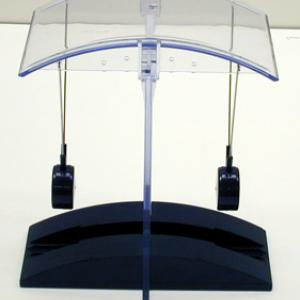College of Liberal Arts & Sciences
3A70.20 - Coupled Pendulum
Start one of the magnetic pendulum swinging. The magnetic coupling will transfer energy from one pendulum to the other pendulum and back again.
- Praveen Pathak, Yogita Patel, Rishi Raj, "Magnetically Coupled Oscillators and a Smartphone", TPT, Vol. 62, #6, Sept. 2024, p. 463.
- Peter F. Hinrichsen, "A Simple Moment of Inertia Measurement", TPT, Vol. 60, #4, April 2022, p. 292.
- Young-Ki Cho, "Teaching the Physics of a String-Coupled Pendulum Oscillator: Not Just for Seniors Anymore", TPT, Vol. 50, #7, Oct. 2012, p. 417.
- Boye M. Odom, "Logger Pro vs. MacMotion", TPT, Vol. 44, #4, Apr. 2006, p. 199.
- Don Easton, "Simplifying the Motion of Coupled Oscillators Using the FFT", TPT, Vol. 44, #1, Jan. 2006, p. 24.
- David Kagan and Chris Gaffney, "Colliding Magnetic Pendula: When Is a Collision Not Collision‐like?", TPT, Vol. 40, #5, May 2002, p. 280.
- Charles A. Sawicki, "Inexpensive Coupled-Oscillations Demonstration", TPT, Vol. 39, #3, Mar 2001, p. 172.
- F. D. Becchetti, A. Dickrill, Richard B. Minnix, and D. Rae Carpenter Jr., "Apparatus for Teaching Physics", TPT, Vol. 22, #4, Apr. 1984, p. 258.
- Arthur R. Quinton, "The Variation of Resistance with Temperature", TPT, Vol. 18, #3, Mar. 1980, p. 213.
- J. Pierrus and M. M. Michaelis, "Demonstration of Coupled Oscillations Using Permanent Magnets", TPT, Vol. 18, #1, Jan 1980, p. 39.
- Monte M. Giles, "A Resonance Demonstration", TPT, Vol. 12, #3, Mar. 1974, p. 178.
- Chenyang Lu, Bentley Turner, Yongsheng Gui, Jacob Burgess, Jiang Xiao, Can-Ming Hu, "An Experimental Demonstration of Level Attraction with Coupled Pendulums", AJP, Vol. 91, #8, Aug. 2023, p. 585.
- Ross L. Spencer and Richard D. Robertson, "Mode Detuning in Systems of Weakly Coupled Oscillators", AJP, Vol. 69, #11, Nov. 2001, p. 1191.
- P. J. Ouseph and John P. Ouseph, "Electromagnetically Driven Resonance Apparatus", AJP, Vol. 55, #12, Dec. 1987, p. 1126.
- Mariam Lahlou, "Interaction forces in Coupled Magnetic Pendulums", Master of Applied Science in Systems Design Engineering Thesis, University of Waterloo, Waterloo, Ontario Canada, 2022.
- "M-960. Coupling-Pendula & Compasses", DICK and RAE Physics Demo Notebook, 1993.
- G. D. Freier and F. J. Anderson, "Mx-12", A Demonstration Handbook for Physics.
- G. D. Freier and F. J. Anderson, "Mx-10", A Demonstration Handbook for Physics.
- Richard Manliffe Sutton, "S-17", Demonstration Experiments in Physics.
- Tik Liem, "The Twin Pendulum", Investigation to Science Inquiry, p. 195.
- Jearl Walker, "The Amateur Scientist: Strange Things Happen When Two Pendulums Interact Through a Variety of Interconnections", Scientific American, Vol. 253, #4, Oct. 1985, p. 176.
- Martin Gardner, "Swinging Cups", Science Tricks, p. 46
- Janice VanCleave, "84. Stop and Go", Teaching the Fun of Physics, p. 125.
- Julien Clinton Sprott, "1.18. Coupled Pendulums", Physics Demonstrations, ISBN 0-299-21580-6, p. 52.
- Jearl Walker, "1.119. Spring Pendulum", The Flying Circus of Physics Ed. 2, p. 58.
- Christopher P. Jargodzki and Franklin Potter, "193. Two Compasses", Mad About Physics, p. 73, 213.
- "Coupled Resonant Pendulums", The Exploratorium Science Snackbook.
- Joseph Priest and James Poth, "Teaching Physics with Coupled Pendulums".
- Robert Ehrlich, "G.6. Coupled Pendulums", Turning the World Inside Out and 174 Other Simple Physics Demonstrations, p. 94 - 95.
- Bobby Mercer, "Swing Your Partner", Junk Drawer Physics, p. 49.
- W. Bolton, "33. Coupled Vibrations", Book 1 - Properties of Materials, Physics Experiments and Projects, 1968, p. 52 - 53.
Disclaimer: These demonstrations are provided only for illustrative use by persons affiliated with The University of Iowa and only under the direction of a trained instructor or physicist. The University of Iowa is not responsible for demonstrations performed by those using their own equipment or who choose to use this reference material for their own purpose. The demonstrations included here are within the public domain and can be found in materials contained in libraries, bookstores, and through electronic sources. Performing all or any portion of any of these demonstrations, with or without revisions not depicted here entails inherent risks. These risks include, without limitation, bodily injury (and possibly death), including risks to health that may be temporary or permanent and that may exacerbate a pre-existing medical condition; and property loss or damage. Anyone performing any part of these demonstrations, even with revisions, knowingly and voluntarily assumes all risks associated with them.
